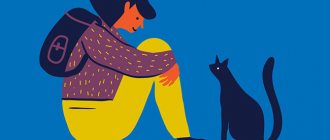Share:
Each of us is individual - this is an axiom. However, often two different people absolutely match each other in terms of body type and physique. In such cases they speak of an identical self-type. In this article we will tell you what body types there are, how to determine yours and how to “correct” it through exercise.
Development and work on oneself asthenics
Many consider the main problem of asthenics exclusively with thinness, although only a doctor can advise an asthenic to gain weight for medical reasons.
More significant is the correction of the emotional palette and features of building your own life. An important point that combines concern for mental and physical well-being is sport. Moreover, it is better for asthenics to choose active, paired, competitive sports or various styles of wrestling. Private yoga classes with an instructor can help you relax and calm your nervous system, but the most important thing is to learn how to control your aggressive outbursts and work with suppressed emotions. Wrestling, running, athletics are places where you can safely release accumulated tension, and therefore protect yourself and your loved ones from random outbursts of anger due to the accumulation of tension.
The more tension an asthenic person can relieve in a safe way, the more internal resources appear, since the psyche spends more energy on restraining itself than on reacting. Everything that could not be realized through active actions should continue to be removed through relaxation. Alcohol and drugs are contraindicated here, since they relax the muscles, but activate the nervous system, causing it to become even more inflated. So after a good workout, massage or swimming is recommended.
You can establish social interaction by setting yourself the goal of meeting a couple of new people every day (or at least every Saturday). The main thing here is not collecting ticks, but trying to find a way of communication in which you feel maximum comfort and naturalness of the situation and your presence in it.
The longest process will be working on your inner feeling and perception of yourself - self-esteem, self-criticism, expectations and demands from others, and so on. Such categories can be dealt with over the course of several months, and to make the process more effective and faster, it is better to seek the advice of a psychotherapist. Stabilization of the emotional background is one of the primary tasks that an asthenic person should work on. The ability to control your emotions and expectations, stop excessive reflection and self-deprecation.
The ability to find sources of energy and fullness will help you not become exhausted at such a rate. For some it will be their own creativity, and for others it will be an opportunity for dosed communication with people. Saving mental resources and their timely replenishment is an algorithm necessary for every asthenic.
Text: Olga Kim
German psychologist and scientist Ernst Kretschmer studied a huge number of people, measuring both their physique and character. In the end, he came to the conclusion that there is a clear relationship between a person’s psychotype and the makeup of his temperament and emotionality. Kretschmer identified three main human psychotypes, one of which is asthenic. What characterizes asthenic?
Does age make a difference?
As we grow older and develop, the weight of the human body also changes. As a child, with the development of the internal organs of the body, the growth of bones, the total kilograms increase. During adolescence, hormonal changes have a major influence. With the development of the genital organs, reproductive system, formation and strengthening of the nervous system and psyche, the mass can either increase or decrease. This process should be considered more as a norm than a pathology.
Between the ages of eighteen and twenty-one, the body largely completes its formation and external development. Further, lifestyle has a significant impact on your figure, in particular, eating habits and food preferences, physical activity, and maintaining water balance.
As a rule, kilograms increase with age. This is considered to be the norm, since a person eats for normal physical and mental functioning. In addition, stress is often consumed, which affects weight without exercise. The ideal ratio of height and weight in women can be found when they watch their figure. They may not gain weight due to a healthy lifestyle.
Thus, slight weight gain is normal throughout life. Let's take a closer look at the recommended indicators in the table below.
Standard body type
Those with a standard body shape have shoulders that are slightly wider than the waist, thus creating the desired V-shaped torso (broad shoulders with a narrower waist). You tend to lose and gain weight very easily.
Some men with a standard body type may have excess weight in the abdominal or chest area. If you have it, admit it, you need to know the enemy by sight.
Let's remember the 3 golden rules:
- Try to look taller - It all depends on your height, however, you can make you taller and slimmer in almost any situation. - We strive for a narrow waist - If you have a belly, then you will have to work on your waist. - Broad shoulders - As a rule, the shoulders have you are wide enough, they just need to be emphasized.
| Suitable for you: • Slim, fitted trousers/jeans/chinos in bright, eye-catching colours. • Blazer with one or two buttons - will create a waist and make your shoulders appear broader. • Light or medium weight knitwear (V-neck jumpers, knitted jumpers). • Shirts, possibly with rolled up sleeves. • Choose a cut that fits your body but is not too tight – “fit” means that the garment is not too tight around your figure. | Avoid: • “Baggy” jeans, flared ones - they will only spoil your figure and upset your proportions. • Loose or wide-cut blazers, jackets or jackets will flatter your figure. • Tight and tight-fitting T-shirts, if you have a belly, will highlight features that you would prefer to hide. • Be careful with short sleeves in any clothing (shirts, T-shirts) - visually they can make your arms look thin and thin. |
Differences between racology and racial studies[edit]
Raciology is now a dead science, if it ever was a science at all. Racial theories before World War II promoted racial inequality and the superiority of one race over another. Raciology received active development in the 1930s in Germany. It is not difficult to guess which type was promoted in these years and in this country as perfect.
Racial studies is a branch of anthropology, and its subject of study is very extensive - from history to the specific characteristics of national groups. This article will touch upon the part of this science that studies the external characteristics of national groups.
Normosthenik ecg
plastic surgeon, oncologist, doctor of the highest category
Electronic periodical: Vladmedicina.ru medical portal of the Primorsky Territory
Founder and publisher: Vladmedicina.ru LLC
Address of the founder, publisher and editorial office: Vladivostok, st. Khabarovskaya, 12. Editor-in-Chief: Mosolov K.V. tel.: , (JavaScript must be enabled to display the address)
Registered with the Federal Service for Supervision of Communications, Information Technologies and Mass Communications, certificate EL No. FS6.
All rights reserved. When completely or partially copying information from this resource, a link to the site is required.
The information provided on the site is for general information only and cannot replace actual medical advice.
There are contraindications. Be sure to consult a specialist!
Difficulties and inconveniences for asthenic people
- low endurance (due to low muscle mass);
- lack of weight (due to rapid metabolism, tendency to neuroses);
- difficulties in communicating with people;
- tendency to frequent acute respiratory infections;
- often - decreased emotional background, anxiety.
How to reduce emotional stress in women of asthenic physique
- normalize work and rest schedules;
- have daily physical activity of moderate intensity;
- rest by switching activities (if mental work is the main one, then it must be periodically changed to physical and vice versa);
- an hour or half an hour before bedtime, you should not read books/magazines/newspapers, surf the Internet, watch TV, etc. to relieve the brain;
- It is advisable to take evening walks for half an hour or more.
Deep breathing into a paper bag during panic attacks.
Development and work on yourself
- Exercise. For example, martial arts. Sports will help you become more disciplined, normalize your schedule, nutrition, and increase endurance. Physical exercise promotes the production of serotonin and other mediators (so-called happiness hormones) in the brain, which have a beneficial effect on mood.
- Learn to relax. You should not use alcohol or drugs, because after their effect wears off, your nervousness will only worsen. It is better to sign up for a massage, go swimming or do some kind of creativity (drawing, handicrafts, cooking).
- Develop social skills. To do this, you need to meet new people at least once a week, communicate more often with your usual company, go out, visit public places. But you shouldn’t learn to communicate via the Internet, because... this will have the opposite effect. When training your communication ability, you need to understand what style of communication is most comfortable, in what situations you can avoid tension and stress.
- Increase your self-esteem to an objective level. You should not either underestimate or exaggerate your qualities. If it is difficult to cope with this task on your own, you can seek the help of a psychologist.
Live communication will help asthenics adapt socially.
Normostenic – Leadership qualities predominate
The average figure of a normosthenic can sometimes even be athletic. A normal metabolism can be an advantage, but an unbalanced diet and excessive consumption of junk food can result in a curvy body shape. This type of personality strives to take a leading position in everything, so not all people manage to find a common language with them. Male normosthenics usually devote a lot of time to their figure, so they look athletic and fit. The female figure of normosthenics is an ideal for many: on average, thin, slightly curvy, but has graceful forms, without unnecessary flaws.
This type of personality spends a lot of effort and energy on subjugating other people, so in order to restore their resources they need to eat well. Normosthenics have an excellent appetite. Excessive enthusiasm for eating food for this psychotype results in obesity.
The normosthenic personality type is ready to take risks without any extra thought, to make every effort to achieve success. Will never be in the shadows, always strives to be on top and wants recognition and standing out among the masses
Uses any means to attract attention and control other people, even to bend them to his will. Normostenic has excellent oratory skills, is overly ambitious, and has a good sense of humor.
He is an emotional person, but when it comes to other people, he is rather cold-blooded and dismissive.
Hypersthenic version of the male figure
The endomorph is crumbly, its body is wide, round and soft. The hypersthenic body type involves short stature and short, thick legs and arms. The main feature of this group of representatives of the stronger sex is their fairly strong legs. This is why stocky athletes achieve good results by training primarily the lower torso (deadlifts, squats, etc.). Due to the fact that the metabolism is weak, weight can very easily increase, but the extra pounds are reluctant to go away. The main advantage of this type is an easy gain of muscle mass, but with it comes fat if weight gain occurs due to poor nutrition. Distinctive features of endomorphs:
Calculate your ideal sports weight!
- Wrist circumference is more than 20 cm.
- Stocky figure: wide hips, shoulders, waist, short legs.
- Short neck, fat deposits between the shoulder blades, on the stomach.
- A variety of sports supplements are not necessary; only the amount of protein in the diet should be sufficient.
- When training, do not forget about cardio training (or circuit training for fat burning) and watch what you eat.
Particular attention should be paid to nutrition. Many athletes make the mistake of completely giving up food and resorting to starvation diets. Fasting can “eat” both fat and muscle mass, and the lost weight soon returns, bringing with it more and more layers of fat.
An example of endomorphs among bodybuilding stars was Jay Cutler.
Features of the endomorph
In people classified as endomorphs or hypersthenics, the transverse dimensions of the body prevail over the longitudinal ones. Their characteristic features:
- broad shoulders;
- wide, barrel-shaped chest;
- relatively short limbs;
- wide pelvis;
- bones and joints are thick and massive.
The muscles are sufficiently developed, as is the subcutaneous fat layer. This is why hypersthenics do not look athletic - they look massive. In general, endomorphs are genetically adapted to perform brute force work; their musculoskeletal and endocrine systems are designed for this.
Tendency to accumulate fat mass
Endomorphs have high levels of testosterone and insulin. It is this combination that allows representatives of the described type to gain weight. At the same time, hypersthenics have a relative predominance of the parasympathetic nervous system, so they love to eat and have sufficient or increased appetite.
This feature imposes on endomorphs the obligation to be very strict about their diet - nutrition for an endomorph must be carefully selected and balanced so as not to once again cause the appearance of excess fat on the body.
It is advisable for people with this somatotype to choose typical strength sports - bodybuilding, strongman, crossfit, rugby. Anything that provides typical work for hypersthenics is suitable - strength and preferably for a certain period of time, sufficient for the increased concentration of cholesterol and blood glucose to be used for energy needs.
Large meals are undesirable for endomorphs: the more the intestinal walls are stretched and the more toned the parasympathetic system is, the greater the reaction of enkephalin and insulin release. Therefore, the classic diet plan for bodybuilders, consisting of 6-8 meals in small portions with a minimally sufficient amount of carbohydrates, is well suited for hypersthenics - both in order to look better, and in order to feel better and avoid a number of the above diseases.
Specifics of the central nervous system
Due to the low level of hormones of the sympathetic system, as well as due to the low manifestation of androgenic activity of testosterone, hypersthenics are not aggressive and are relatively slow. The muscle composition is dominated by glycolytic muscle fibers. Thanks to this, hypersthenics are capable of performing powerful power movements, but in a limited time period. Simply put, hypersthenics by nature don’t have very much endurance.
However, with appropriate training, the mitochondrial apparatus can be developed in glycolytic muscle fibers, which will help correct this deficiency. Impact martial arts are not for them. Endomorphs will feel more comfortable in various types of wrestling, especially where there is a tough ground game - jiu-jitsu, judo, classical wrestling. The limbs of hypersthenics are short, the muscle bellies are thick, the levers are not long - it is easier for hypersthenics to demonstrate maximum strength due to the reduced amplitude. For the same reasons, endomorphs will feel comfortable in arm wrestling and powerlifting.
Areas of sports implementation of an endomorph
A large amount of adipose tissue may lead to the idea that hypersthenics need more cardio exercise. This is not true at all. The joints of endomorphs are large, formed by the joints of fairly thick bones. Such structures, even at rest, require significant blood supply, which they receive from the surrounding muscles. Cardio loads the joints, while not only not increasing, but even decreasing the amount of muscle tissue.
So the most optimal would be a special training program for endomorphs, combining heavy strength training and volumetric bodybuilding training. In this case, the diet should be complete, providing growing muscles with sufficient energy. But it is better to reduce the amount of carbohydrates - this way we will reduce insulin emissions, reduce the amount of adipose tissue and allow testosterone to more effectively perform its task in building muscle and reducing the percentage of subcutaneous fat.
Let’s not forget that “drying” will be much more difficult psychologically and physically for a hypersthenic person, which will have a very negative impact on the latter’s health.
The nature of this personality type
The characteristics of a person depend on his somatic condition and the type of organization of the body. The sensitivity and mobility of the nervous system, the ability to transform stressful experiences through the body's reaction, the influence of hormonal levels - all this physically determines the temperamental and personal characteristics of normosthenics.
Thus, for the character of a normosthenic person, great importance is usually attached to the emotional sphere, which will be the leading motive or an important companion of any activity. The love of physical activity and the ability to express on a physical level allow negative emotions to circulate freely, so such people may appear overly aggressive, although they simply do not suppress negative or protest feelings. But sometimes emotional capture plays against normosthenics, increasing the risk of a hypertensive crisis or heart attack. Accustomed to unleashing an aggressive whirlwind without stopping, a normosthenic runs the risk of rendering his own nervous system unusable, and without much help from others. The strength of somatic and psychological parameters in most cases causes people to give up or simply leave.
They also have an innate appetite for risk, which is a consequence of their confidence in their own physical strength. Note that the more physically helpless a person is, the less he will take risks in other matters, while a stable position at least in the body gives more confidence. Such self-confidence sometimes borders on the desire to solve many problems by dominating or showing strength. This is usually typical for normosthenics whose level of intelligence is at an average level, or who had deficiencies in socialization. At a high level of development, this tendency to take risks is transformed into excellent qualities of managers and organizers, those who are able to change the current state of affairs and bring not only their lives, but also the lives of other people to a new level. The ability to take risks, accompanied by a high level of responsibility for every decision, makes a normosthenic a leader, even if he does not document his position.
These people love to be the center of attention. In attractive versions, this is achieved thanks to their charm, sense of humor, oratorical and leadership qualities; in negative versions, their desire for attention can lead to loud talking and sarcastic remarks. They love speaking in public or being among crowds. An unfamiliar audience does not frighten, but on the contrary, stimulates normosthenics, giving them a surge of energy and interest, new ideas and concepts.
The desire to compete is present everywhere, from the choice of sport to the approach to work.
This means that a normosthenic is more interested in the moment of victory in competition than in achieving a specific goal. Sometimes only the presence of competitors can make them get up and get what they have long wanted, and if no one else shows enthusiasm in this direction, the normosthenic will move on to other things for now. The goal for them should always be clear, the task should be clear - this involves meticulousness and spontaneity of action. These are the people who save a burning project, a failed performance, or solve insoluble problems.
In terms of communication, normosthenics are nice, open people who easily win the sympathy of others and have a wide circle of friends. However, they do not go deep into relationships, they often lack empathy for other people, and are rather cold towards both the joys and misfortunes of even those close to them. The combination of this communication style and leadership qualities allows them to occupy leadership positions. Intolerance to shortcomings makes normosthenics innovators, inventors, and reformers.
Of the intrapersonal options, normosthenics are still recommended to learn to control the manifestation of their own strength, especially in the form of aggression. Another weakness is breadth of acquaintance instead of depth. Therefore, it is necessary to learn to feel and understand others on a deeper level and build long-term and trusting relationships.
Normosthenics need clear frameworks and schedules, clear goals and objectives. This can be done by looking for suitable positions or projects, as well as taking on the planning function, setting new goals again and again. Otherwise, irrepressible vital energy will find realization in destructive forms, such as bad habits, inadequate emotional reactions, competition at times when coordinated work is necessary, and much more.
Classifications of body types according to body components.
Classification of body types by bone component.
- Thin-boned (asthenic) body type. Women with this body type have long limbs, thin bones, a long and thin neck, and relatively weakly developed muscles. As a rule, representatives of the thin-boned type are light in weight; they are active, active and even with increased nutrition they gain weight slowly.
- Normal (normosthenic) body type. As a rule, they have a beautiful, proportionally built figure. The main body dimensions are distinguished by the correct ratio.
- Broad-boned (hypersthenic). Representatives of this body type have larger transverse body dimensions than normosthenics and asthenics. They are distinguished by wide, thick and heavy bones; their shoulders, chest and hips are wide; legs are short. Women with this body type are most likely to be overweight.
Classification of body types by fat component.
Group 4 (additional) - with increased fat deposition in certain areas of the body,
MammaТtrochanter
Classification of body types by muscle component.
Main features:Additional features:Note.
| Constitutional scheme of V.V. Bunaka (1941) | ||
| Types | Characteristics | |
| Basic | Chest | It is determined by the weak development of fat deposits and muscles. The chest in men of this type is flat or sunken. The abdomen is also sunken. The back is stooped. |
| Muscular | It is distinguished by the average development of the fat component and strong relief muscles. The chest has a cylindrical shape. The stomach is straight. The back is normal or, less commonly, stooped. | |
| Abdominal | Has an increased development of the fat layer, while the muscles are moderately or poorly developed. The chest has a conical shape. The belly is convex. The back can be of different shapes - normal, straight or stooped. | |
| Intermediate | Thoracic | Similar to the pectoral type, but the chest is not as flat and the muscles are quite well developed. |
| Muscular-thoracic | Similar to the muscular type, but differs from it in a low degree of fat deposition and a more flattened chest. | |
| Musculo-abdominal | Similar to the muscular type, but differs in an increased degree of fat deposition and a more conical shape of the chest. | |
| Abdominal-muscular | Similar to the abdominal type, but differs in fairly well-developed muscles | |
| Undefined | Actually undefined | Any other body types that do not fit into the presented scheme based on the combination of characteristics. For example, thoraco-abdominal (TH-B) and abdominal-thoracic (B-G) with signs of both thoracic and abdominal types: poor muscle development, low fat deposition, while a swollen abdomen and a cylindrical chest may be characteristic. |
| Abnormal | A wide range of abnormal body types associated with a certain pathology obvious to the researcher (for example, dystrophy, dysplasia, pituitary obesity, hermaphroditism and other pathological options). |
The advantage of V.V.’s scheme BunakaDisadvantages.










